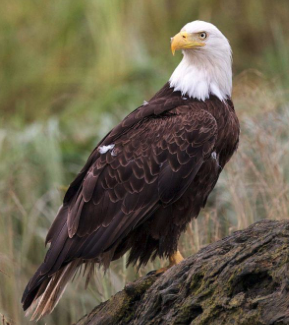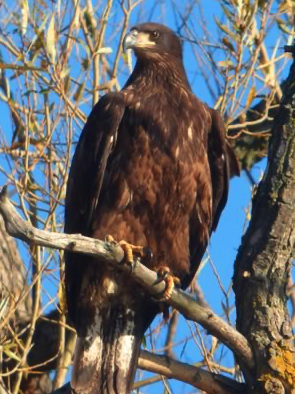Eagles of Ontario:
Two types of Eagles in Ontario. They are the Bald Eagle and Golden Eagle. Eagles are iconic ‘king of the skies’ due to their size and power. Once on Ontario's endangered species list have made a comeback in recent years. Eagles live to 25-40 years. Eagles also mate for life.Bald Eagle

Reproduction: Sexual maturity is reached at 4-6 years of age. Nests are huge, constructed with sticks usually near the top of a tree and close to water.1-3 eggs are laid and approximately half will survive the first year.
Diet: Feed on live or dead fish, aquatic birds, along with smaller mammals, amphibians and reptiles. Deer carcasses are a major source of food in Ontario’s winter. Keen vision allows them to see prey on the ground or in the water while in flight. Strong beaks and sharp talons grasp and carry away their food. They will steal prey of other birds especially Ospreys.
Species Information: Wingspan of up to 2 m. These eagles don’t get their characteristic white head and dark brown body until they reach maturity at FIVE YEARS OLD. Until then, these birds have all sorts of different plumages and streaky browns and whites on their bodies. Even their beak changes colour. Females look similar to males, except they’re about 25% larger. Juveniles have dark brown heads and bodies with variable white mottling or streaking until they reach their fifth year. Bald eagles make their homes in forested areas near large bodies of water.
Golden Eagle

Reproduction: The female lays two black eggs between January and September (depending on the locality). They start incubation immediately after the first egg is laid, and after 45 days on average the young hatch. They are entirely white and are fed for fifty days before they are able to make their first flight attempts and eat on their own.
Diet: Hunts animals such as rabbits, marmots, squirrels or even smaller birds.
Species Information: Golden Eagles are not commonly seen in Ontario and migrate through the province. The Golden Eagle is a large bird, with a wingspan of up to 8 feet (2.4 meters). As one of the largest birds in North America, Golden Eagles are extremely powerful and agile. They can reach up to speeds of over 240km/h when they dive for their prey. Golden Eagles use their speed and sharp talons to hunt.



